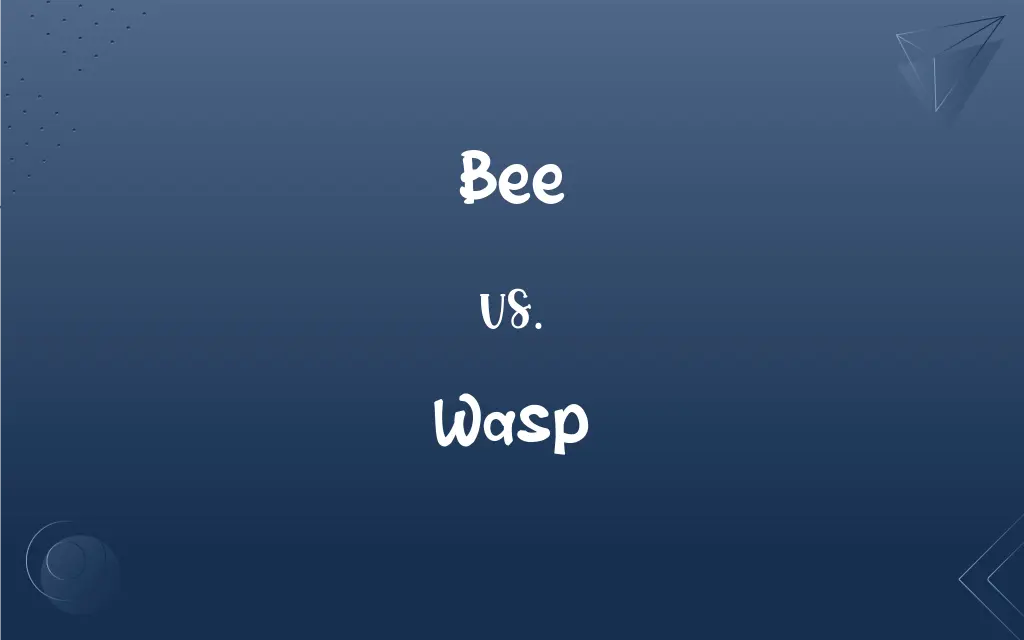Bee vs. Wasp: What's the Difference?
Edited by Aimie Carlson || By Harlon Moss || Updated on October 14, 2023
Bees are pollinating insects that produce honey, while wasps are typically predators or parasitoids without honey production.

Key Differences
Bees are members of the Apidae family, known for their role in pollination and their ability to produce honey. Wasps, on the other hand, come from the Vespidae family and are generally not involved in pollination, but they play roles as predators or parasitoids of other insects.
While both bees and wasps can sting, bees usually sting as a defense mechanism and die afterward because their stingers are barbed and get stuck, causing them harm. Wasps can sting multiple times, as their stingers are smoother and don't remain lodged in their victims.
Physically, bees are often fuzzier due to their hair-like structures called setae, which aid in collecting pollen. Wasps have a sleeker, more streamlined body without as much hair.
Bees, in general, are more docile creatures, mainly focused on collecting nectar and pollen. Wasps can be more aggressive, especially when provoked, and they often hunt other insects for food.
Social structures differ between bees and wasps too. While honeybees live in large colonies with complex social structures, many wasp species are solitary. There are, however, some social wasps like yellowjackets that form colonies.
ADVERTISEMENT
Comparison Chart
Family
Apidae
Vespidae
Primary Activity
Pollination & honey production
Predation or parasitism
Physical Appearance
Fuzzy with hair-like structures
Sleeker and less hairy
Sting
Usually once, then dies
Multiple times
Social Structure
Mostly social with colonies
Solitary or social colonies
ADVERTISEMENT
Bee and Wasp Definitions
Bee
A gathering of people to perform a task or hold a competition.
We're having a quilting bee at my house this weekend.
Wasp
A flying insect known for its sting and slender body.
The wasp built its nest under the eaves of my house.
Bee
A sharp prolonged noise, like that made by a flying insect.
The constant bee of the alarm made him jump.
Wasp
Acronym for White Anglo-Saxon Protestant.
The old literature often references the WASP elite.
Bee
A flying insect known for pollination and producing honey.
I watched the bee land on a flower and collect pollen.
Wasp
A sharp, sudden sound.
The wasp of the whip startled the horses.
Bee
A hardworking person.
Jane is always the busy bee, managing work and home with ease.
Wasp
A person with a thin waist.
Her wasp waist was the envy of many.
Bee
An emblem of industriousness.
She wore a brooch shaped like a bee to symbolize her dedication to work.
Wasp
A person with a sharp or spiteful demeanor.
She has a waspish tongue when she's angry.
Bee
Any of numerous winged, hairy-bodied, usually stinging hymenopteran insects of the superfamily Apoidea, including both solitary species and social species such as the honeybees, and characterized by sucking and chewing mouthparts for gathering nectar and pollen.
Wasp
A white person of Protestant English or other Northern European ancestry, especially one belonging to the American upper class.
Bee
A gathering that combines cooperative labor and social interaction or friendly competition
A quilting bee.
Wasp
A member of Women's Airforce Service Pilots, organized during World War II as part of the US Army Air Forces to ferry aircraft and to test new aircraft. The organization was disbanded in 1944.
FAQs
Can both bees and wasps sting?
Yes, both can sting, but bees usually sting once, while wasps can sting multiple times.
Are all bees social creatures?
While many bees are social, there are also solitary bee species.
Do wasps play a role in pollination?
Generally, wasps are not significant pollinators, though some might inadvertently pollinate.
Can wasps be aggressive?
Yes, some wasps can be aggressive, especially when provoked.
What do bees mainly feed on?
Bees mainly feed on nectar and pollen.
Why do bees die after stinging?
Bees have barbed stingers that get lodged in, causing harm to the bee.
What do bees primarily produce?
Bees primarily produce honey.
Are bees and wasps beneficial for gardens?
Yes, bees help with pollination, and wasps can control pest populations.
Where do wasps build their nests?
Wasps can build their nests in various places, including trees, under eaves, or in the ground.
Do wasps produce honey?
No, wasps do not produce honey.
How do wasps differ in appearance from bees?
Wasps generally have sleeker and less hairy bodies.
Are there bee species that don't sting?
Yes, some bee species, like the stingless bees, don't sting.
Are there different species of bees?
Yes, there are thousands of bee species.
Can all wasps sting multiple times?
Most wasps can sting multiple times, but not all.
Are there solitary wasp species?
Yes, many wasp species are solitary.
How do bees contribute to the environment?
Bees are essential pollinators, helping in the reproduction of plants.
What is a bee's habitat?
Bees live in various habitats, from forests to gardens and usually in hives or nests.
Which is more dangerous, a bee or a wasp?
Both can be dangerous if provoked, but wasps can be more aggressive and can sting multiple times.
What do wasps eat?
Many wasps are predators, feeding on other insects.
Are wasps harmful to gardens?
While some wasps can be nuisances, they can also be beneficial by preying on garden pests.
About Author
Written by
Harlon MossHarlon is a seasoned quality moderator and accomplished content writer for Difference Wiki. An alumnus of the prestigious University of California, he earned his degree in Computer Science. Leveraging his academic background, Harlon brings a meticulous and informed perspective to his work, ensuring content accuracy and excellence.
Edited by
Aimie CarlsonAimie Carlson, holding a master's degree in English literature, is a fervent English language enthusiast. She lends her writing talents to Difference Wiki, a prominent website that specializes in comparisons, offering readers insightful analyses that both captivate and inform.































































